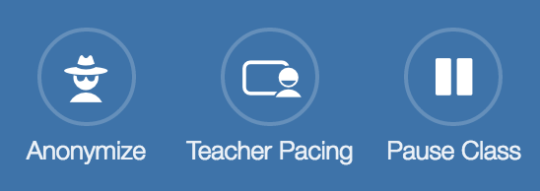
We’re proud to debut our free Classroom Conversation Toolset, which has been the labor of our last three months. You can pause your students’ work. You can anonymize your students’ names. You can restrict the pace of your students through the activity. We believe there are productive and counterproductive ways to use these tools, so let us explain why we built them.
First, the edtech community is extremely excited about personalized learning – students learning at their own pace, uninhibited by their teacher or classmates. Our Activity Builder shares some of that enthusiasm but not all. Until last week, students could click through an activity from the first screen to the last, inhibited by nothing and nobody.
But the cost of personalized learning is often a silent classroom. In the worst-case scenario, you’ll walk into a classroom and see students wearing headphones, plugged into computers, watching videos or clicking multiple choice questions with just enough interest to keep their eyes open. But even when the activities are more interesting and cognitively demanding than video-watching and multiple choice question-clicking, there is still an important cost. You lose collective effervescence.
Collective effervescence is a term that calls to mind the bubbles in fizzy liquid. It’s a term from Émile Durkheim used to describe a particular force that knits social groups together. Collective effervescence explains why you still attend church even though the sermons are online, why you still attend sporting events even though they’re broadcast in much higher quality with much more comfortable seats from your living room. Collective effervescence explains why we still go to movie theaters; laughing, crying, or screaming in a room full of people is more satisfying than laughing, crying, or screaming alone.
An illustrative anecdote. We were testing these features in classes last week. We watched a teacher – Lieva Whitbeck in San Francisco – elicit a manic cheer from a class of ninth-graders simply by revealing the graph of a line. She brought her class together and asked them to predict what they’d see when she turned on the graph. They buzzed for a moment together, predicted a line, and then she gave the crowd what they came for.
She brought them together. She brought back the kids who were a bit ahead and she brought forward the kids who were a bit behind. She de-personalized the learning so she could socialize it. Because arguments are best with other people. Because the negotiation of ideas is most effective when you’re negotiating with somebody. And because collective effervescence is impossible to experience alone.
So these tools could very easily have been called our Classroom Management Toolset. They are useful for managing a class, for pausing the work so you can issue a new prompt or so you can redirect your class. But we didn’t build them for those purposes. We built them to restore what we feel the personalized-learning moment has missed. We built them for conversation and collective effervescence.
